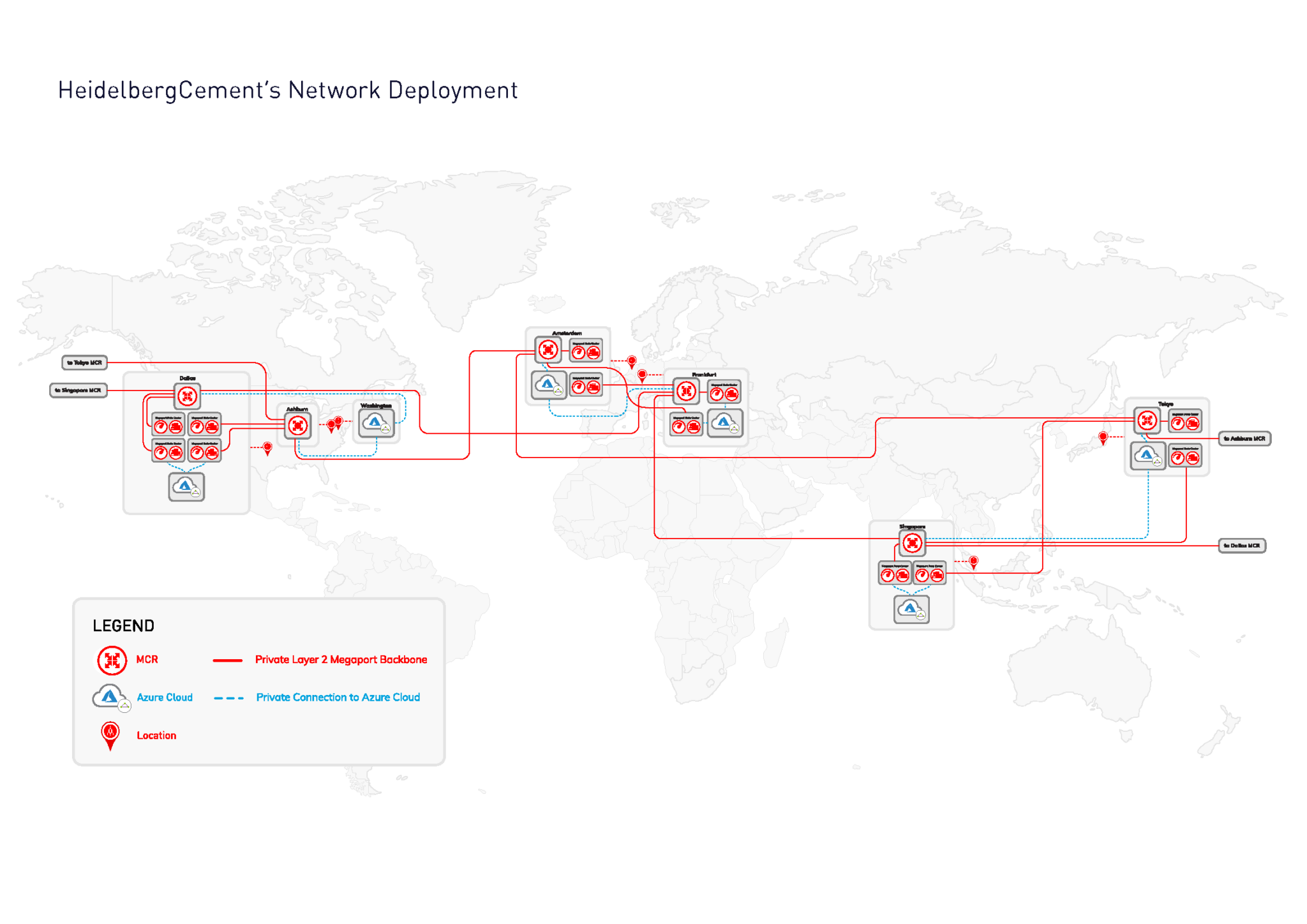
About Heidelberg Materials
Heidelberg Materials is one of the world’s largest integrated manufacturers of building materials and solutions, with leading market positions in aggregates, cement, and ready-mixed concrete. Around 53,000 employees at more than 3,000 locations in over 50 countries deliver long-term financial performance through operational excellence and openness for change.
At the center of actions lies the responsibility for the environment. As a forerunner on the path to carbon neutrality, Heidelberg Materials crafts material solutions for the future.
Key Points
- Used Megaport’s Network as a Service (NaaS) as a single, multi-region network backbone to replace private MPLS lines from numerous providers.
- Simplified network management and routing by reducing the number of connectivity vendors requiring management and reducing troubleshooting, which could take anywhere from several weeks to several months.
- Significantly reduced total cost of network ownership to the point that they can now quadruple their international bandwidth usage and still run a more cost-effective network than they had without Megaport.
- Improved visibility of their network backbone with full routing tables and doubled the speed of their network.
Case Study Snapshot
As one of the world’s largest manufacturers of building materials, Heidelberg Materials was supported by a complex, global enterprise network that spanned multiple regions and was becoming increasingly expensive, difficult to manage, and time-consuming to upgrade. After choosing Megaport’s Network as a Service to be its single, global network backbone, Heidelberg Materials now runs a network that can quadruple its bandwidth capacity at a lower cost.
Challenges
As one of the world’s largest building material companies, Heidelberg Materials was supported by a complex, multiregion enterprise network that connected via private MPLS circuits from numerous providers. Traffic for their North American and Asia-Pacific region terminated into their European region because of the way network connectivity was configured. Their network architecture presented a number of challenges:
- Managing the multi-vendor environment was difficult: Heidelberg Materials had to use multiple portals, and some providers couldn’t advertise all their routes.
- Adapting quickly to bandwidth requirements was a struggle: If they wanted to upgrade private links to meet the demands of applications that consume more bandwidth, it would require router upgrades on the provider’s side that could take weeks or even months.
- Lack of routing visibility internally made routing exceedingly complex: Because of some providers’ limitations on route advertisements without additional costs, Heidelberg Materials’ IT team struggled to troubleshoot connectivity issues, having to login to multiple portals and open numerous support tickets with their providers.
“We were using [route] summarizations for our providers, and these summarizations were creating unwanted issues,” Vladimir Sivak, Network Specialist at Heidelberg Materials, said. “Every few weeks we needed to tweak these summarizations to make the connectivity work as required.”
In short, Heidelberg Materials’ network was simply not future-proof, not cost-effective, and becoming increasingly difficult to manage.
Solution
“Everywhere we have doubled the speed.”
With the help of Megaport’s solutions architects, Heidelberg Materials replaced private MPLS circuits in six data centers around the world with Megaport connectivity. Heidelberg Materials and Megaport designed a solution with full mesh connectivity using redundant Megaport Cloud Routers (MCRs) in Europe, North America, and Asia-Pacific.
The MCRs were connected with Virtual Cross Connects (VXCs) in a dual global ring topology. The solution was architected to ensure a proper High Availability (HA) deployment. In the event of any network issues, there would be seamless failover without requiring intervention from the IT Operations team.
Since deploying the solution, Heidelberg Materials now has full visibility into their backbone, with full routing tables on all the MCRs and all the routers on Heidelberg Materials’ side. They no longer have to use the route summarizations that were causing connectivity issues.
They also no longer have to use multiple portals from multiple vendors; they can engage support in one place: on the Megaport portal.
Perhaps most importantly, Sivak adds, “Everywhere we have doubled the speed, and we are ready to go even further, if required. Connectivity to our cloud providers is running at double-speed. And all our inter-regional traffic is also doubled.”
Benefits
“We can multiply our bandwidth four times and still have lower cost than before.”
Sivak also appreciates Megaport’s “get it done” ethos. “I have not heard ‘This is not possible,’” Sivak said. “So far we’re able to find a way in all the use cases – to somehow make it work. This is rare.”
For Heidelberg Materials, the benefits of using Megaport are as follows:
Faster: Heidelberg Materials’ network speeds have doubled across the board since using Megaport.
Cheaper: Sivak’s team put together a business case to move away from private links from multiple providers that took into account internet, MPLS, and cloud costs. Sivak said that the business case concluded that with Megaport, “We can multiply our bandwidth four times and still have lower cost than before from a total cost of ownership perspective over the next five years.”
More reliable: Since deployed, Heidelberg Materials hasn’t touched the solution. “When nobody is talking about connectivity,” Sivak said, “it means it works.”

Future Plans for Heidelberg Materials
Currently using Microsoft Azure, Sivak says that Heidelberg Materials plans to use Megaport to utilize more cloud providers, deploying pilot projects in various clouds. If they used an internet-based underlay instead of Megaport, Sivak said, the bandwidth necessary for these applications would be difficult to achieve.
In addition to considering connecting regional headquarters and country hubs directly into the Megaport backbone, Heidelberg Materials is also evaluating SD-WAN solutions, which might open up use cases for Megaport Virtual Edge to replace hardware in on-premises sites.
